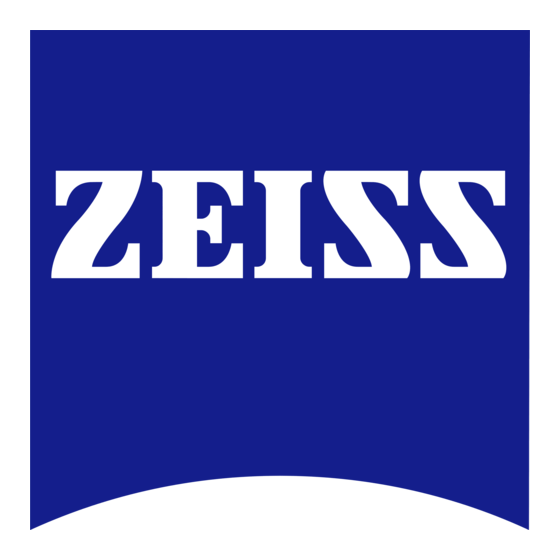
Table of Contents
Advertisement
Quick Links
Advertisement
Table of Contents

Summary of Contents for Zeiss Cryo Trap
- Page 1 Instruction Manual ZEISS Cryo Trap...
- Page 2 Effective from: 11/2019 © 2019 Without the prior written consent of ZEISS, this document or any part of it must neither be translated nor reproduced or transmitted in any form or by any means - including electronic or mechanic methods, by photocopying, recording or by any in- formation or filing system.
-
Page 3: Table Of Contents
7.3 Dismounting the Cooling Plate................. 16 7.4 Installing the Cooling Plate ..................16 7.5 Defrosting the Dewar ....................16 8 De-installation and Disposal ................17 9 Troubleshooting....................18 Instruction Manual ZEISS Cryo Trap | en-US | Rev. 2 | 346000-8166-000... -
Page 4: About This Document
ZEISS 1 About this Document This instruction manual is considered to be part of the Cryo Trap. It offers topics which are specific to the Cryo Trap. For information regarding the ZEISS field emission scanning electron microscope (FESEM), please refer to the relevant manual before starting to work with the Cryo Trap. -
Page 5: Text Conventions And Link Types
See page 5 for further information on text See: Text Conventions and Link Types [ 5]. conventions and link types. https://www.zeiss.com/corporate/int/ Link to a website on the internet. home.html Tab. 2: Link types Instruction Manual ZEISS Cryo Trap | en-US | Rev. 2 | 346000-8166-000... -
Page 6: Definition Of Terms
Unwanted absorbation of volatile hydrocarbon compounds at speci- men and instrument surfaces Cryo Trap Reduces the contamination in the specimen chamber Dewar Isolated can, containing the liquid nitrogen FESEM Field emission scanning electron microscope Instruction Manual ZEISS Cryo Trap | en-US | Rev. 2 | 346000-8166-000... -
Page 7: Safety
4 Safety 4.1 Intended Use The Cryo Trap is used to cool down the area below the objective lens while the object chamber is at vacuum. This decreases contamination by binding the volatile hydrocarbons. The Cryo Trap is an option for the following ZEISS field emission scanning electron microscopes (FESEM) with airlock: §... -
Page 8: Warning Labels And Lights
NOTICE Damage of components inside the chamber In case the chamber is vented before the Cryo Trap is warmed up, the water from ambient air will condense at cold surfaces inside the chamber. Do not vent the specimen chamber as long as the dewar is filled with liquid nitrogen. -
Page 9: Description
Position The Cryo Trap is a purely mechanical device that is attached to the EDS3 port of the GeminiSEM chamber. The Cryo Trap assembly includes a dewar vessel mounted outside, an adapter flange connecting it to the specimen chamber, a thermoconducting rod plus a metal plate reaching near the electron beam. -
Page 10: Principle Of Operation
The compounds are deposited at the cooling plate. The cold surface of the cooling plate acts as a trap for hydrocarbons and hence decreases the risk of contamina- tion. Instruction Manual ZEISS Cryo Trap | en-US | Rev. 2 | 346000-8166-000... -
Page 11: Technical Data
(4.5 hours to reach 20°C). System vacuum Improvement of an approximate factor of 2 5.4 System Requirements § Airlock § Liquid nitrogen, has to be provided by the customer Instruction Manual ZEISS Cryo Trap | en-US | Rev. 2 | 346000-8166-000... -
Page 12: Detector Compatibility
With cooling plate in position, untilted stage movement is uncompromised. A stage tilt of 45° is possible, but the possible range of WD strongly depends on sample/sample holder. Fig. 3: Tilted stage with cooling plate and detectors Instruction Manual ZEISS Cryo Trap | en-US | Rev. 2 | 346000-8166-000... -
Page 13: Installation
ZEISS 6 Installation 6 Installation The Cryo Trap is either factory-installed or retrofitted by authorized ZEISS service personnel. Instruction Manual ZEISS Cryo Trap | en-US | Rev. 2 | 346000-8166-000... -
Page 14: Operation
Explosion risk if the pressure inside the dewar rises due to evaporating liquid nitrogen. Only use the cover which is provided by ZEISS for the dewar filling hole. Regularly check that ice does not build up at or around the cover for the dewar filling hole. -
Page 15: Filling The Dewar With Liquid Nitrogen
ZEISS 7 Operation | 7.1 Filling the Dewar with Liquid Nitrogen Always exchange the specimen via the airlock, when the cryo trap is cooled down. Info Ensure, that the borehole in the lid does not face the specimen chamber. 7.1 Filling the Dewar with Liquid Nitrogen Prerequisite ü... -
Page 16: Dismounting The Cooling Plate
7.5 Defrosting the Dewar Defrost the dewar to avoid icing in the vacuum chamber. The procedure is the same as the procedure for venting the specimen chamber [ 15]. Instruction Manual ZEISS Cryo Trap | en-US | Rev. 2 | 346000-8166-000... -
Page 17: Installation And Disposal
ZEISS 8 De-installation and Disposal 8 De-installation and Disposal The Cryo Trap is de-installed and disposed of by authorized ZEISS service personnel only. Instruction Manual ZEISS Cryo Trap | en-US | Rev. 2 | 346000-8166-000... -
Page 18: Troubleshooting
Check position of borehole of the specimen chamber lid. Long pumping The specimen chamber has been Defrost the dewar. time vented while the temperature of the Cryo Trap was far below room temperature. Instruction Manual ZEISS Cryo Trap | en-US | Rev. 2 | 346000-8166-000... - Page 20 Carl Zeiss Microscopy GmbH phone: +49 3641 64 3161 Carl-Zeiss-Promenade 10 fax: +49 3641 64 3439 07745 Jena info.microscopy@zeiss.com Germany www.zeiss.com/microscopy...
















Need help?
Do you have a question about the Cryo Trap and is the answer not in the manual?
Questions and answers